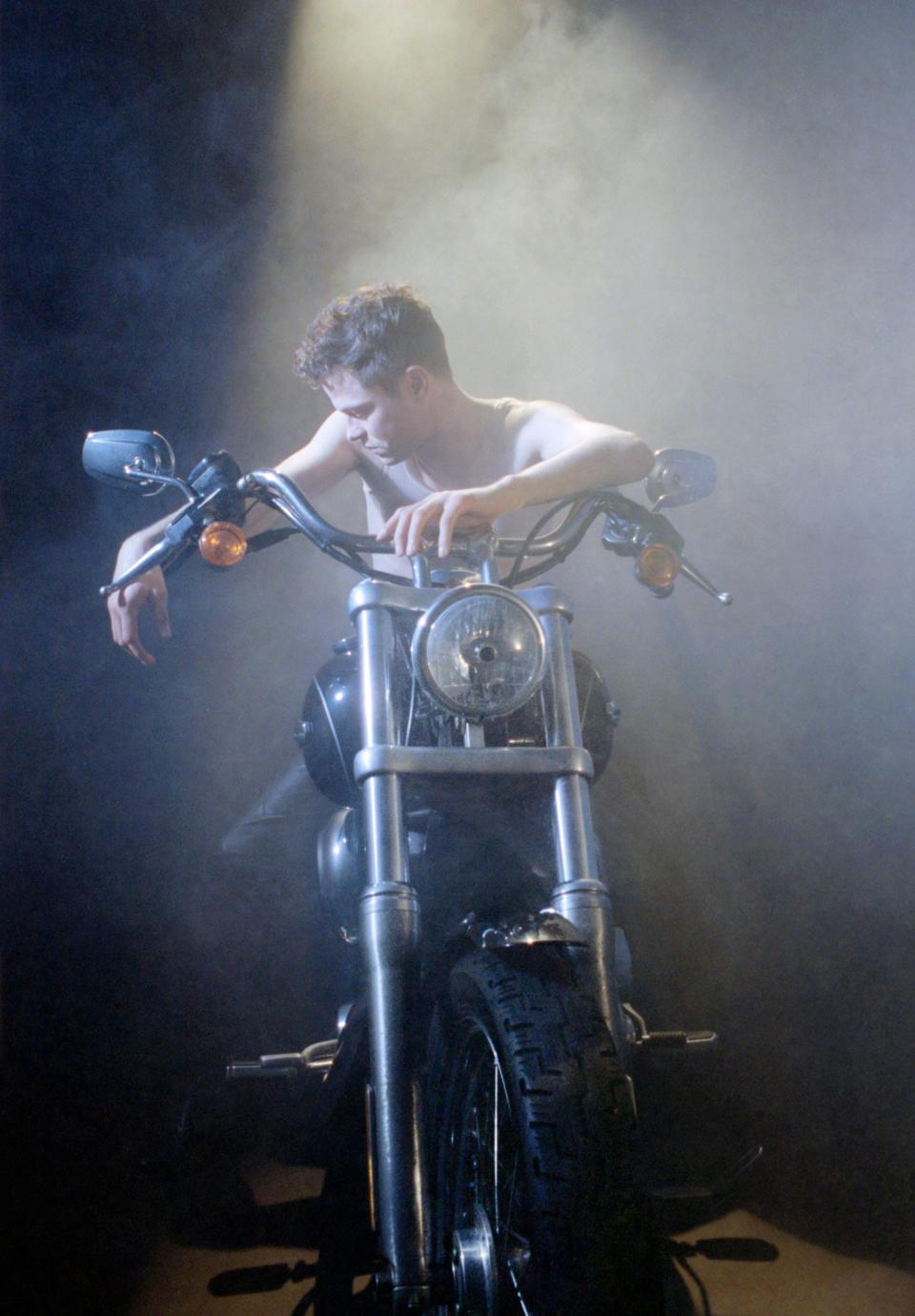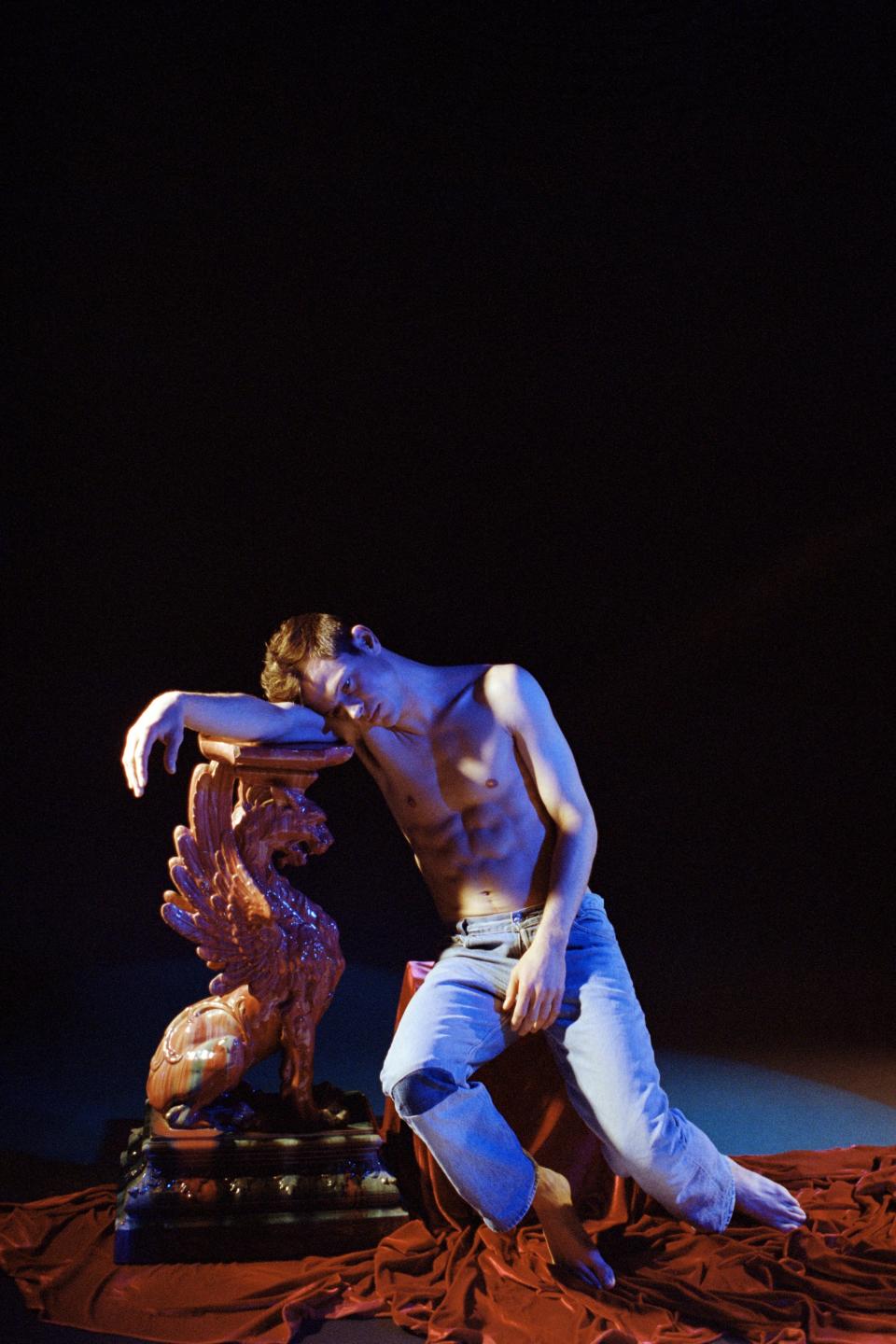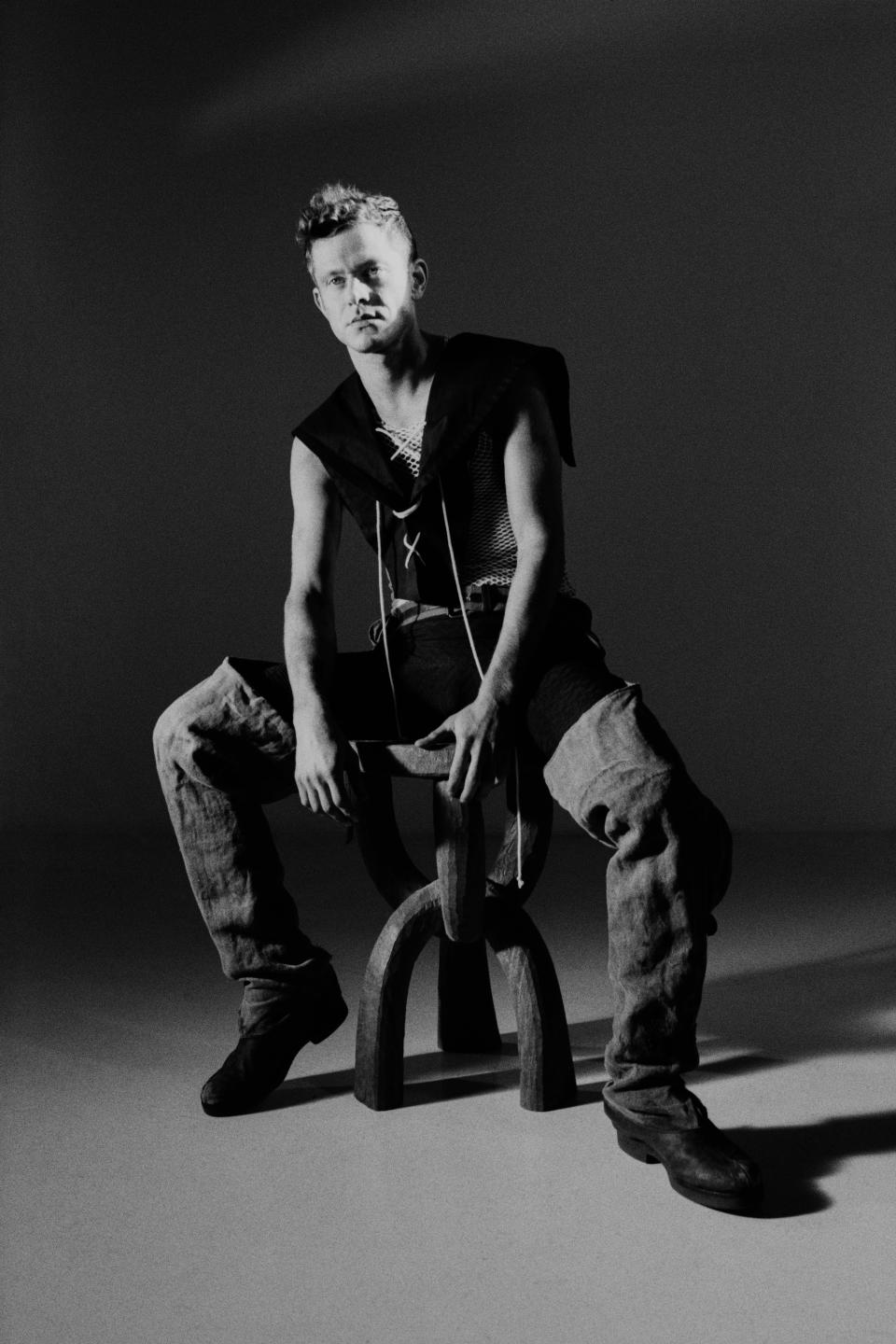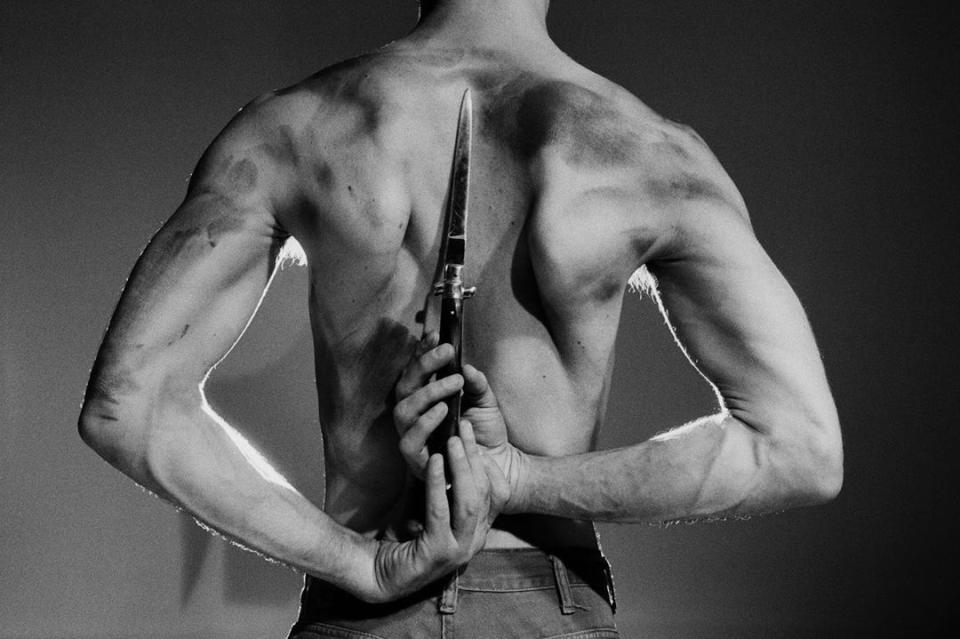Perfume Genius Talks Camp, American Masculinity, and Marlon Brando’s Tank Tops
“Can disruption be beautiful?” asks Ocean Vuong, the award-winning poet, author and MacArthur Genius Grant recipient, in his introduction to Perfume Genius’s new album, Set My Heart On Fire Immediately. Vuong goes on to describe a body that represents the record, one that “sings itself into the future,” a body that is “queer, healing, troubled, wounded, possible, and gorgeous.”
For Mike Hadreas, the 38-year-old mastermind behind Perfume Genius and whose new record is released today, the words reflect his complicated relationship with both his own body and how he relates to the bodies of others. It’s a subject that has served as a running theme throughout much of his music—often relayed through the prism of Hadreas’s experiences of addiction, sexual abuse, and Crohn’s disease—and one that he returns to in bracingly candid terms with his latest release. “It's just that stuff that's in-between or underneath,” says Hadreas over a video call from his home in Los Angeles. “What I admire about Ocean is that he perfectly puts a name on and describes something that was indescribable before, some feeling, and it's beautiful, too. I just greedily wanted some of that to be connected to it in some way.”

While Vuong’s words serve as a neat complement to Set My Heart On Fire Immediately, Hadreas is perhaps underestimating his own skills as a lyricist, and his ability to capture those moments just as effectively. For those who have followed the rise of Perfume Genius over the past decade, it‘s been a journey of increasing returns. His first two albums, 2010’s Learning and 2012’s Put Your Back N 2 It, consisted of intimate, confessional bedroom pop where, despite the starkly literal lyrics, Hadreas himself remained mostly behind the scenes. (He laughs when I remind him of the fact that Learning’s cover is literally his own face scratched out and covered with paper towels.) But with the release of the thunderous lead single “Queen” and its accompanying video in 2014 for his third album, Too Bright, Hadreas the performer emerged in full technicolor, standing front and center as the defiant face of his, now decade-long, musical project.
His aesthetic ambitions have grown even bolder with each subsequent release. The visuals for 2017’s No Shape, shot by Inez & Vinoodh and styled by Mel Ottenberg, saw Hadreas cavorting in leather trousers against backdrops of dusty pink flora and soft-focus landscapes—a head-spinning mash-up of ’60s gay hustlers, James Bidgood’s Pink Narcissus, and the bucolic paintings of Watteau—yet somehow a perfect reflection of the record’s exuberant, decadent spirit. “I think of it as world-building, really,” Hadreas explains. “I had clear ideas for this record of how I wanted it to be, how I wanted it to look, how I wanted it to be seen and heard and everything. I consider myself very lucky to be able to work with all of these visionaries, though.”
View the full album on Spotify here:
Hadreas’s evolving sartorial interests have proved to be equally agenda-setting in their own, quiet way. Pop music may have a rich history of gender-bending fashion, but the approach Hadreas has taken when experimenting with style from record to record has been more nuanced—a lick of red lipstick here, a glittering silver mesh tank top there. He’s rarely spotted on the front row at fashion week, but this more authentic, intentional queering of masculine style codes have established him as a singular figure in the world of pop when it comes to fashion. Its influence can be felt, however subtly, in the style choices made by a new generation of culturally literate queer musicians like King Princess and Troye Sivan.


Where Hadreas feels most comfortable, however, is speaking about the impact of film on his work, which is more palpable than ever with Set My Heart On Fire Immediately. Where his references previously were easier to pinpoint, this time Hadreas pulled from a very different selection of cinematic flotsam and jetsam. The forceful choreography was inspired by the exhilarating final scene of Claire Denis’s Beau Travail, in which the film’s main character dances wildly to DeBarge’s “Rhythm of the Night” in a Djibouti nightclub; the video for single “Describe” pays homage to the carefully-arranged tableaux of Derek Jarman’s Caravaggio; the muddied tank top he wears on the cover of the record, meanwhile, is lifted straight from Marlon Brando’s wardrobe in A Streetcar Named Desire, a look that is now a paradigm of American masculinity. “I’ve always been really into that look since I was a kid,” Hadreas explains. “Since I was little, it's represented something to me, and I also love how it's been made gay.”
Indeed, the look might feel instantly familiar, but it’s the details—the hazy lighting, the smudges that are applied just a little too artfully—that lend it an air of something a little more playful, and winkingly queer. For the album artwork, Hadreas worked with the French photographer Camille Vivier whose images have a timeless quality he was aiming to reproduce in the music, along with stylist Ai Kamoshita. “I love the campiness of it, and how dead serious it can be at the same time,” Hadreas adds. “I wanted to harness all that, but also have it all exist in this kind of void state. You know, I'm presenting as masculine but I can only do so much—I can present as hyper-masculine, but you look at it and you think, there's something about it which doesn't seem fully there. That’s what I love about it.”
It’s also visible in the video for lead single “On the Floor,” which sees Hadreas in a hempy tank top humping a huge, ever-so-slightly phallic rock tied up with chains, before writhing around over a stack of rubber car tyres and engaging in a dramatic push-and-pull with a male dancer dressed in a matching outfit. While promoting the record, Hadreas has referenced his collaborations with choreographer Kate Wallich and her company as a key influence. (“I worry now I've talked about them too much, actually,” Hadreas says, with a laugh. “They're gonna be like, dude, this guy's fucking obsessed with us.”) It’s present, too, in the sense of tactility that runs through both the lyrics of songs like “Just a Touch” and “Jason,” the latter of which graphically recounts an early sexual experience where Hadreas’s partner remained fully clothed.
It feels ironic that an album so steeped in human contact should be released at a time when nobody will be experiencing it played as a live set, or catching it performed on a late-night show, but on this, Hadreas is unbothered. “So many times I go to shows and I'm like, this is enjoyable, but I wish I like just listening to the song at home—although I guess that's like a really shitty thing to say as a musician,” he adds, giggling again. “When you are in the room with people and watching something, though, and it really does connect, it's way more powerful than when you're listening at home. It's just harder to achieve. It's harder to get that catharsis and that full-bodied feeling.”
Either way, Hadreas describes the record as “intimate,” which feels appropriate given the inevitability that for most of his fans, listening to it for the first time will take place on headphones or speakers in their bedrooms. “I have this very home-centric relationship with music, and even when I write I'm very much by myself,” he continues. “Maybe it's a safety thing. Maybe I can't really relax enough when I'm going to see a show, or I'm too self-conscious or something to really give myself over. To me, this feels like the most cohesive, album-y album I've ever made. Even if it's varied sonically, it feels like a record, and the songs could only exist together, and people can really go deep into this record if they have the luxury of doing so right now, which is nice.”

As Hadreas philosophises on the strange situation of releasing and promoting an artistic endeavour during lockdown, it’s his ever-present sense of humor that keeps him grounded. He pauses at one moment to poke fun at his self-described “Goop-y pretentiousness” when talking in more abstract terms about the impact working with the dance company had on the record, and why his dog is wearing a recovery collar (“too much scratching,” apparently).
View the full album on Apple Music here:
But while Hadreas has been unable to fulfil every corner of the visual ambitions he had for the record, like further music videos, the imagery produced with Vivier and Kamoshita is enough to tell that story all on its own—and the current limitations feel, for Hadreas, like coming full circle to his early days as a musician. “When you're first starting out, you can't tour as this fully cinematic, visual experience. It would just be me and a band playing but, you know, I wanted fog machines and fronds and velvet and all this stuff. But at the same time the fact that we could just roll up to some dive bar with my band and being able to somehow transport everybody, that's satisfying in its own way too. There's something nice, this time, about it just being just the music.”
Originally Appeared on Vogue

